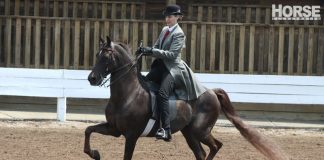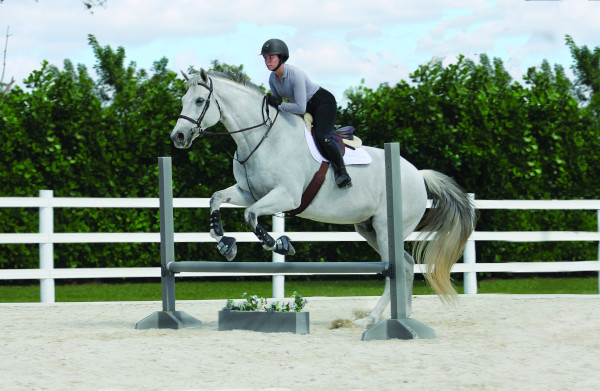
You may have heard about “seeing” and “looking for” distances at the horse jumps. The problem with this approach is that it only deals with what occurs in the immediate vicinity of the jump. Much more important than the takeoff stride at the jump are all the strides that come before it, through the corner, and from the landing of the previous horse jump. After all, jumping is just flatwork with sticks in the way.
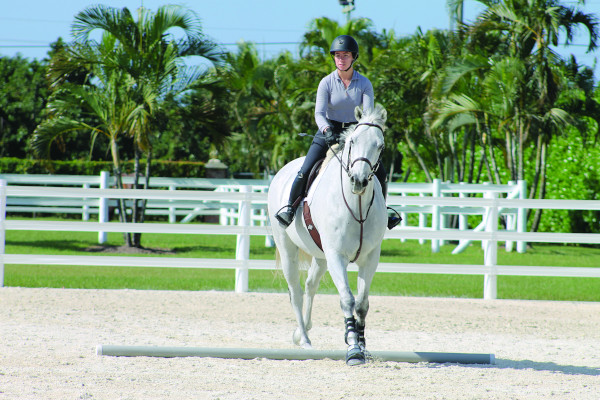
Rhythm and Balance for Better Horse Jump Takeoffs
The quality of the canter is defined by two components: rhythm and balance. Balance is created through half-halts no matter what speed the canter is. Because horses naturally carry 60 percent of their weight on the forehand and 40 percent on the hind end, it is our job as riders to shift 20 percent of that weight to put 60 percent on the hind end and 40 percent on the front end.
Balance of the canter can certainly have an effect on the rhythm of the canter: a horse that has more of his weight on the forehand will naturally gain momentum and get faster and faster with a longer and longer stride through no fault of his own—it’s just physics.
The rhythm you choose depends on the horse, jump height, and questions being asked on course. For example, the rhythm for a cross-rail or 2′ course will be slower than the one used for a 3′ to 3’6″ course. Horses or ponies that are less athletic will likely need a slightly faster rhythm to jump 2’6″ to 2’9″ than horses that are more athletic.
Try This Exercise
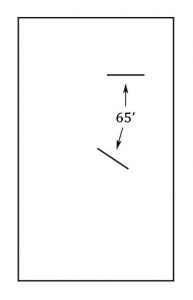
As mentioned earlier, another element of creating the takeoff stride is the track. For all hunters and lower-level equitation, the best track is the one that, upon landing, follows the arena fence until you can easily see a straight, perpendicular approach to the middle of the next jump.
A great, low-impact way to practice the concepts of regulating track and quality of the canter is to set up two poles or small jumps in a bending line with 65 feet from center to center (see diagram).
Once you have warmed up, use an energetic rhythm to canter through the bending line, finding the track that perpendicularly intersects each pole at the center, counting your strides. The number of strides you just did in the line is what you should use as your “original number.”
Your next goal will be to do your original number plus one. Evaluate your track and quality of canter from the first time you rode the line, and think critically about which you will change in order to successfully add a stride. If you were very careful in your track, you likely won’t have much to change except a slower rhythm with more balancing half-halts.
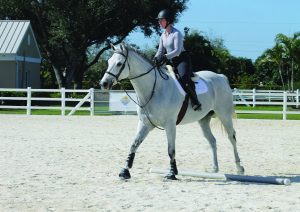
The next task is to do your original number minus one stride. This can be done by riding each pole at an angle, eliminating the stride in the middle of the line previously used to turn.
Rhythm can be adjusted by speeding up the canter and increasing the length of stride, while a few well-timed balancing half-halts will ensure your horse is not barreling along on the forehand and dragging you through the exercise.
Once you have worked on the track and quality of the canter, understanding where your horse jump will take off becomes much easier. Because you are so in tune with your horse, each stride becomes very predictable.
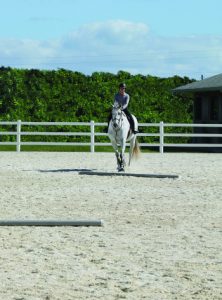
Your horse will be much better able to deal with the jump in front of him when there is a straight, well-planned approach and a balanced, rhythmic canter. Because his weight is already shifted to his hind end, he will be more adjustable on the approach to the jump. He will also be more likely to push off with strength in his hindquarters and round his back, creating a better jumping effort.
Be sure to practice horse jumps evenly in both directions, noticing if one lead is more difficult than the other. The more you practice, the more you will understand how to use track, rhythm, and balance to benefit each horse you ride. And arriving at a workable takeoff spot will become easier and easier with this tried-and-true formula.
This article about improving horse jump takeoffs appeared in the April 2021 issue of Horse Illustrated magazine. Click here to subscribe!




